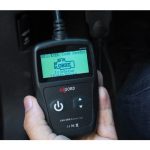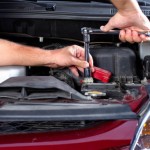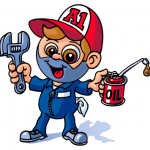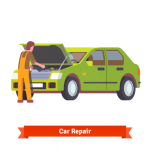As if making the automobiles for today ‘smart’ was not enough, technology has even provided smart diagnostic tools that make owning a car a luxury. The OBD reader is one such tool that every vehicle owner should have – repeat, every vehicle owner. You don’t have to be a mechanic or to be crazy about your car to own this tool, it is the ultimate must have tool.
An OBD reader or scanner is a software tool capable of reading the problem with your car and giving detailed information of the problem. The reader makes it possible for you as a car owner, to diagnose your car before proceeding to check in at the mechanics. The OBD reader is able to help you save money because you will be able to know what the problem with you gaggling or buzzing vehicle is or when your engine’s vehicle lights are randomly lighting, and therefore avoid unnecessary costly repairs.
What’s an OBD Reader?
An OBD reader is the scanning tool (interpreter) for the On-board Diagnostics (OBD) tool found in modern vehicle models. The OBD reader has been in use since 1996. The reason you didn’t know about this specialised tool is because it was monopolised by mechanics who were the only people that were able to access and use it.
Today, these scanners are affordable and easy to get a hold of. This means you can save money by doing the ground work on your car that’s signalling a problem. You will be able to save money by either preventing the problem from heightening, or by simply knowing the rough estimate you should be charged by the mechanic so that you are not charged for unnecessary repairs.
Technical Specs
The following is an overview of the most common things that the OBD reader monitors in a vehicle. Not all models will have all the features but if there are specific features you want then you can simply search for the OBD reader that encompasses those. And of course, the more sophisticated the OBD reader model and brand, the more expensive it will be.
- Monitor torque and horsepower
- Check battery voltage and charging conditions
- Read vehicles calibration verification numbers, calibration identifications, and identification numbers
- Send data through email
- Check emissions levels
- Make and view GPRS data
- Record strips and save on iPad/iPhone
- Test oxygen levels
- Freeze data points during a certain set of time
- Report on fuel usage and make comparisons with the duration the car has been driven
- Report on customised features (Only reports on the features you specified that you want to see)
- Synchronize to a computer to print data reports that you can take to the mechanic or repair shop.
When You Sense Danger with Your Automobile
You will realise how having this automotive scanner will make you calm even in situations where other motorists who don’t know about the scanner would normally panic. For example, when you are warned by your car to “Check engine light” unlike other motorist you won’t have to run to the mechanic. Here’s the ROI; most mechanics will charge you about $100-$200 in addition to other extra costs every time you go for this service.
The prices of different models of the automotive scanners vary, but it is a cost you pay once for a gadget that you can use for the lifetime of your vehicle. Think about the number of times you will get the ‘check the engine light’ error. Do you see how crazy the savings you’ll make by having the automotive reader are?
Having a scanner will in fact promote the relationship between you and your mechanic because you will be going to them knowing the exact services you want. You will also save time wasted on checking unnecessary details and factions, and we all know time is money.
The General Procedure for Diagnostics Testing Using an OBD-II Reader
Every vehicle that is equipped with an OBD reader has a diagnostic connector (J1962 16-pin) which will feature the same generic codes when the vehicle has some fault. What this means is that the OBD code reader or scanner that you purchase should be compliant with your vehicle in order for it to be able to check for readiness and read the codes and clear them. As a state requirement, all vehicle inspections facilities like repair shops will also have a complex plug-in tool that can also record the vehicles data.
Different models and brands of OBD reader have slightly varying instructions for use.
The following is a general process that cuts across all the different brands and models.
- First turn off your vehicle when you notice a strange sound or the check engine lights. Check for the data like connector usually located on the left or under the steering wheel. This connector outlet is what you use for accessing the diagnostic computer for your automobile for any updates or troubleshooting.
- Connect the OBD reader cable to the data link connector. The end of the cable features a 16-pin plug that is able to perfectly fit into the cars outlet. Be careful when connecting the cable because the pins are very delicate and might bend when force is applied or the surrounding plastic on the plug may break.
- Either turn the car’s ignition “on” or have the car running according to the specific requirements by the OBD reader model.
- There are models where you’ll be required to turn on a power button on the reader, while there are other models where the reader will automatically turn on once you have turned on the ignition.
- When the reader indicates that it’s ready, initiate a ‘read’ or ‘scan’ of the diagnostic system of your vehicle. The reading process also varies with different OBD models. While there are models with a basic button, for others you will be required to go through several menus to initiate reading. If this is the first time you’re using the OBD reader, simply scan through the manual to be sure of what to do.
- When the auto code reader has finished the process, you will be provided with a diagnostic trouble code (or codes). If your car code reader has Bluetooth capability, you can search for the codes online. Else you can use the USB provided to connect the reader on your laptop and check for the codes. You could also just write down the codes and check them from a desktop or laptop not connected to the reader.
- Most manuals have the most common generic codes that cut across all types of vehicles so you can simply cross check the DTC codes with your manual. There are vehicle manufacturers who will also provide you with an extra set of codes so you can cross check with these from your auto repair manual or online.
- After you are done recording the error codes, switch the car off or turn the ignition to the ‘off’ position and carefully unplug the OBD reader.
Understanding Your Vehicle via Your OBD Reader
There are two types of generic error codes that your OBD reader will report; trouble codes (P1) or vehicle maintenance (P0). P1 codes indicate that your car needs more technical repairs and therefore you should head to the mechanic. P0 codes on the other hand are an indication of vehicle maintenance like low radiator fluids. Some P0 and P1 codes are specific to vehicle models and therefore you should either check with your auto repair manual or from online codes. There are also OBD reader models that are not capable of displaying all OEM-enhanced codes. These have limited use capability and may not fully show you the problem with your vehicle.
It’s important that you also select OBD readers with diagnostic features like special scan tool software, special diagnostic test modes requiring a two way communication, snapshot data and codes history.
For some OBD enabled vehicles for 1996 models and newer ones, you can use a personal digital assistant (PDA) or a cheap Palm Pilot with a cable and a scanner software to read or clear most of the error codes. You can also use a DIY reader if you have one. Faults on your vehicle that need to be displayed in waveforms or graph may require you to purchase a digital storage oscilloscope, but these are very few.
Save Money on Emissions Testing
Most states require that you undertake a regular emissions testing for your vehicles. This was previously done using the emissions analyser or dyno but with the OBD reader one can perform the tests easily and faster. Moreover, the OBD reader is more reliable for emissions testing because the OBD II systems can monitor emissions 24/7 all year round.
With the OBD reader, your vehicle will be able to easily detect evaporative emissions leaks an also detect a drop in the efficiency of the converter. You will definitely know there is a problem when you get a code for a converter problem or an EVAP while the MIL is on. While the problem may not necessarily affect the performance of your vehicle, it is important that you fix it before the MIL goes out to avoid violation of standard state laws.
The OBD II will check for fuel vapour leaks with every driving cycle and in so doing monitor evaporative emissions. This is done though application of pressure or a vacuum to the charcoal canister, vapour lines and fuel tank. If no air flow is detected while the EVAP purge valve is opened, the leakage rate that will be detected is 0.020 inches 2000 model vehicles and newer ones (o.o4o inches) which is an indicator of a faulty vehicle.
There are cases where finding a leak using the OBD reader can be challenging. This is for example when the error code is P0440 which in an indicator of a fuel vapour leak. In this case, you should start by searching for a leak in the gas cap because a damaged or loose-fitting cap is capable of allowing enough air leakage that the OBD reader can code. Sometimes you may need to use a dye/smoke leak detector to be able to find a leak in the vapour hose.
The Most Common Problems Detected by OBD Reader
The emissions problem is the one most detected by OBD reader. This is because the OBD has been designed to turn on the MIL in the event that there is a fault in the vehicle which may cause it to exceed the emissions limit set by federal state by 150 percent. By the time you’re getting an error code for an emission problem it means the fault with the vehicle has happened more than once.
It’s not all the times that an MIL comes on there’s an emissions problem. There are other times that the MIL will come on for more insignificant reasons like a loose gas cap. These are normally minor problems that won’t affect the functionality of the vehicle. You cannot know what the problem is however, unless your vehicle is diagnosed.
Because most vehicles will normally provide no indication of the problem when the check engine light (MIL) turns on, as a motorist in such a vehicle you will be terrified and confused by not knowing whether the problem is something minor or something big. You will also be scared of how much repairs for your vehicle will cost you. It’s thus justifiable to be worried about the ‘light’ – and you should be because without a proper diagnosis a seemingly minor problem might be exuberated.
Even professional repair mechanics know how difficult diagnosing driveability and emissions problems with late-model vehicles can be. In some cases, it’s not just a matter of reading a code. The OBD reader is an efficient self-diagnosis tool but it is only capable of identifying faults in particular systems or circuits. It won’t however tell you the components to repair or replace. This is why sometime an additional diagnostic work will be required to isolate the problem.
Example of problem that a Diagnostic reader will be able to alert you on but can’t comprehensively show you includes evaporative emissions leaks and misfires. The cause of misfires can be a compression problem, a fuel problem or an emissions problem, but it will usually have an underlying cause like an open or shortened injector which the OBD reader can’t diagnose and will compel you to use other diagnosis mechanisms. The good thing is that the problem won’t come as a surprise to you because you will have known of it upfront from the OBD reader.
Know What You Can Do and What You Can’t
Most vehicle owners only know the basics when it comes to car maintenance. That is, flushing out the radiator or a simple oil change. Very few people therefore have the in-depth knowledge required to do other vehicle repairs. So although you will be able to identify the problem using the OBD reader, it’s critical that you don’t attempt repairs that you don’t have proper training or tools to carry out. Attempting such repairs may jeopardize the health of your car and cause you to churn out even more cash at the repair shop so it’s better to take your vehicle to a professional mechanic with the codes so that they can perform the repairs. A repair job like replacing timing belt is complicated and may actually cause your car to stall until a mechanic looks at it.
How Cheap Can An OBD Reader Get?
You’re probably familiar with the adage, “cheap is expensive”. Although an OBD reader can help you save immensely on your car repairs, only the good quality ones will actually serve this purpose. There are two versions of an OBD reader, the first version which was previously used for monitoring vehicle emissions and other small problems, and the OBD II, which is the latest version that comprehensively scans OBD enabled vehicles.
There are many brands and models of the OBD II and it’s therefore not necessary to settle for the OBD no matter what great discounts online sales sites or shady repair shops offer you. Once you have decided to buy the OBD reader, ensure that you shop for the right one for your car and with the right specifications. The manner of connection is what is important and not the codes because you can always download this information from a secondary source.
An OBD Reader Is a Long-Term Investment
There’s no doubt that investing in a good quality OBD reader is a long-term investment. You will be able to save money by not requiring frequent visits to the mechanic shop for repair and maintenance you can do on your own. With the right skills and automotive tools you can even do moderate repairs which will enable you to increase your savings further. With the OBD reader, you will be able to determine when visiting a professional mechanic is necessary and when you can take on the repair task on your own.
Verdict
The OBD reader is an efficient tool that can be used to interpret the message from the OBD tool in your automobile. This gadget, in actuality, can help you understand the exact problem your vehicle is having and the actual location of the problem. Because it is able to show you what triggered the “check engine light”, the OBD reader is helpful in preventing accidents. You are also able to analyse your vehicles performance issues using the OBD reader and thus can save on the cost of vehicle repairs.






